Taking responsibility for expressing a resolutely presented opinion can only be a deeply felt role. This, of course, involves knowing how to defend one’s own thinking even considering in extremis those cases in which this is not particularly exemplary or additive, especially if we have already been made aware of it. It can also happen that a popularizer, a critic or an essayist, sometimes, does not necessarily have to maintain that deified and extremely loaded, slavish and pedantic role, which could be imposed from the outside; a “mask”, so he himself can allow himself to be removed when the curtain is finally down.
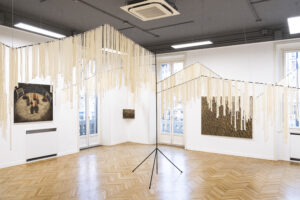
Andreas Zampella, Dove nascono gli uccelli, 2023, installation view, courtesy the artist and Nashira Gallery, Milan
The artistic act of Andreas Zampella leads me to think, as a user, that those multiple realities that lie behind the masks will always remain hidden, that the game of intrigue is what drives me, as an investigator who follows the same case perpetually, to try in vain to reveal them. “Dove gli uccelli” (Where the birds are born), title of the first solo exhibition at the Nashira Gallery in Milan inaugurated on March 15, is already a deception in itself. Where do birds come from? From the egg, of course. But where does the egg come from? And here is the absurd. Zampella’s paintings, therefore, do not lend themselves to the chains of narrative logic, nor to the desire of the reader to expect the word “end” on the last page of a book, since his paintings do not sequentially tell a story, but they must be studied individually and thought disconnected from each other, although visually they are joined together for the use of polychrome clay and mixed with clay, carefully mixed with oil.
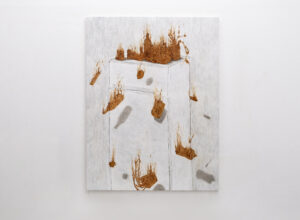
Andreas Zampella, Natura morta su frigorifero, clay, enamel, oil in canoa, 160 x 120cm, 2022, courtesy the artist and Nashira Gallery, Milan
Even those figurative elements that the artist chooses to represent, are stripped of their predictability or purpose of being exclusively subjects or objects linked to their name. The idea of suspending the finiteness, as well as the vanitas, of which the still life from the Flemish to Morandi is evocative, is altered in Natura morta su frigorifero (2022): the burning objects break the traditional stasis, throwing themselves into a white void, visually describing not only an upward tension, but also a downward dynamism. On the other hand, the same domestic elements that resign themselves to the void, meet fire convivially in a dining table – pranzo al buio (2022) – enclosing in them their potential dynamism through the continuous presence of flames and, still, their staticity in setting the table with clay features, surrounded by a dark mantle. The polar presence of concepts, the dichotomy of opposites, the unexpected poetic unpredictability of the staging amplify the evocative and seductive aspect that Zampella’s “non-thetical” domestic scenarios purposely express.
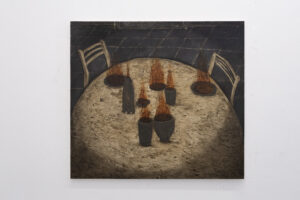
Andreas Zampella, Pranzo al buio, clay, oil, graphite on canvas,118 x 108cm, 2022, courtesy the artist and Nashira Gallery, Milan
If the “non-tetycity” foresees an absence of judgment, in which the existence of the subject and the exclusion of the predicate is asserted, in the works of Zampella objects, animating in flames and floating in space, are charged with a tensive force confirming, In fact, this epoch – abstention – leaves the spectator uncertain and confused. The eternal state of captivity that hides behind the definition of the name, conditions the eye to hold with pride to know how to see and recognize. But the recognizability of a represented object, Sartre would say, does not determine the function of the observed image, but only its synthetic consciousness, a “quasi-observation” (from Jean-Paul Sartre, L’immaginario. Psicologia fenomenologia dell’immagine a cura di Raoul Kirchmayr, pp-26-27, PBE Piccola Biblioteca Einaudi, 2007, Torino). The first reading of an image, therefore, is based on the search for an element mnemonically recognizable, and then collect other data that can determine a consciousness. If, however, this element is decontextualized by its usual function, as Duchamp did with the objets trouvés, the nature and/or certain truth of the latter is ironically questioned by the observer, to the point of considering it absurd. But is the truth in question? Or our blind pride? And it is precisely in bottiglie di notte (2023) that the role of voyeur is no longer entrusted to the human but to the object: a bottle that Zampella personifies by painting it in different forms and clustered, giving them a look, as if they were many small masks.
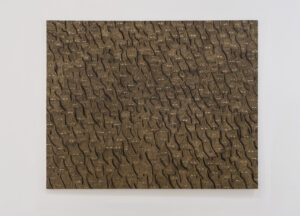
Andreas Zampella, Bottiglie di notte, clay, oil on canta, 135 x 170cm, 2023, courtesy the artist and Nashira Gallery, Milan
Behind the abstraction of the clayey brushstroke, behind a sculptural curtain, at the same time rigid and soft, Composizione su due treppiedi (2023) shows a blurred and distracted vision, in which a sharp and bloody muscle is hidden. Argilla del mio cuor (2022) is an invitation, perhaps, from the artist not to be deceived by the vision of space in its entirety, nor by its spectacular presentation, but to approach and let oneself be observed by what we intentionally consider negligible.
Info:
Andreas Zampella, Dove nascono gli uccelli
15/03/2023 – 15/05/2023
Nashira Gallery
Via Vincenzo Monti 21, Milan
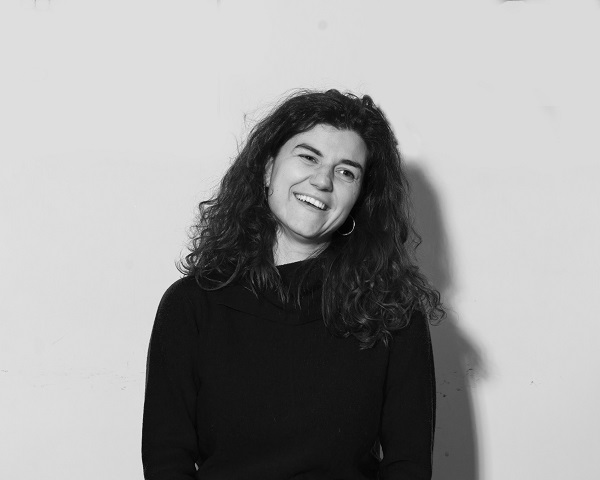
Graduated in Architectural Sciences at the Sapienza University in Rome, with a master’s degree in Contemporary Art and Management at the Luiss Business School, she currently works as an intern and project manager at Untitled Association. Graduated in Photography and Art Criticism in Bologna, she currently carries on her personal projects and is part of the team of the Forme Uniche cultural project.






NO COMMENT